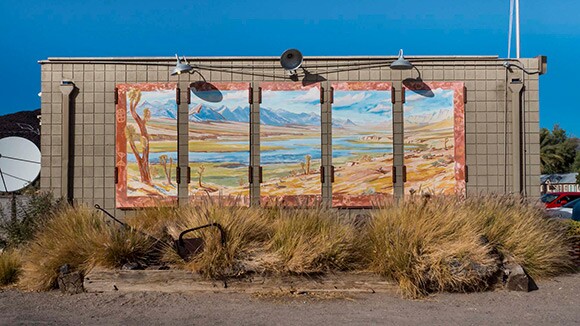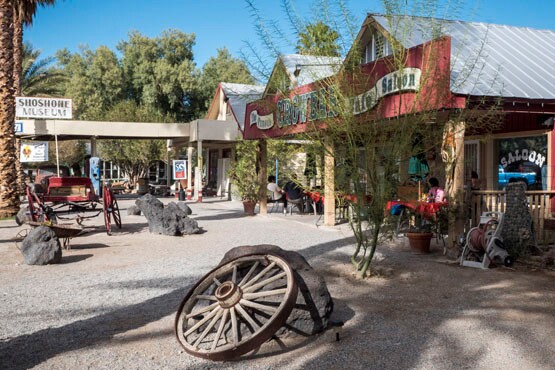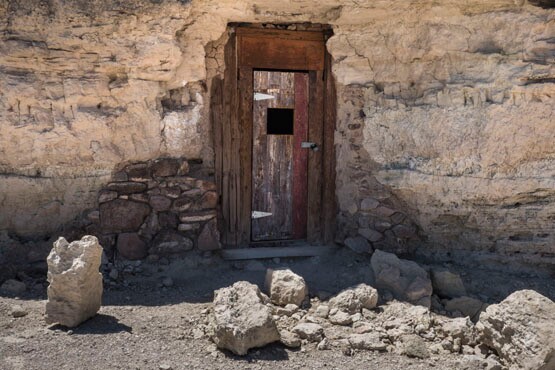The Mojave Project: Reimagining the Amargosa
The Mojave Project is an experimental transmedia documentary by Kim Stringfellow exploring the physical, geological and cultural landscape of the Mojave Desert. The Mojave Project reconsiders and establishes multiple ways in which to interpret this unique and complex landscape, through association and connection of seemingly unrelated sites, themes, and subjects thus creating a speculative and immersive experience for its audience.

In hindsight, Susan Sorrells did not intend to stay in Shoshone. In her late 20s and living in Geneva, Sorrells was at the time heading towards a career as a diplomat or even a photojournalist, when she found herself returning to the tiny desert hamlet owned by her family for four generations to attend to her mother who had recently become chronically ill. But stay on she did, which is likely why this tiny village has metamorphosed into the off-the-beaten path ecotourism gem that it is today.

As a Smith College graduate in English with a Masters in African Studies from UCLA, the energetic and socially conscious Sorrells had already done a Peace Corps stint in Liberia along with an internship for California Senator Thomas Kuchel in Washington D.C. This is not particularly surprising as politics are in her blood: Susan's grandfather Charles Brown had been a member of the California State Senate, while her father Maury had served as an Inyo County State Supervisor. By the time Sorrells found herself returning to Shoshone to manage the town's affairs, she was already a seasoned world traveler with aspirations far beyond the physical boundaries of this one-horse town. So why did she decide to stay?
Shoshone, located on California State Route 127 due east of Death Valley as the crow flies, was founded by her great-grandfather prospector Ralph Jacobus "Dad" Fairbanks in 1910. Fairbanks had set up shop along the Tonopah and Tidewater Railroad, trading provisions with miners of the region. Her family continued to provide supplies and services, earning a comfortable living for the next 60 years while hosting an interesting mix of regular visitors, including the renowned modernist architect Richard Neutra, who ended up designing Susan's family home.

By the mid 1980s, the town -- like many throughout the region -- was suffering from the decline of the localized mining economy, the primary employer for the majority of area residents. Historically, there had been up to 50 operational mines throughout the Amargosa and Death Valley -- mainly talc but also gypsum, gold, silver and lead. One by one, these small operations began to shut down after being bought out by larger multinational mining corporations. As Shoshone's population dwindled, the quaint village, with its people and the surrounding hills that Sorrells and her brother had so loved to explore while on horseback, began to fade.
Before Susan's mother passed, she encouraged Susan to move forward with her own life rather than holding onto Shoshone's past; the town's character was based on the unique individuals that spent their lives there and eventually they, too, would pass. Still, Sorrells felt the pull of this unique small-town life, binding family roots, and invested personal history.

With support from her husband Robert Haines, the two began the transition of reviving Shoshone into a tourist destination that would bring the outside world to their door. Initially their plan proved far too successful. Immediately, real estate developers began eyeing the valley for future subdivisions. Off-road enthusiasts began to frequent the area with a minority of more reckless riders threatening to damage the fragile riparian wetland habitat of the Amargosa River and destroy ancient paleo treasures found in abundance just outside of town.
By switching their focus to sustainable ecotourism, the couple was able to curb the unwanted development and unwelcomed illegal off-roading activities. To do so, Sorrells recognized that her family's lands along with those of the larger Amargosa Basin required preservation through a nonprofit land trust in order to protect it for future generations. About the same time she was exploring this idea, she met Bill Christian of the Nature Conservancy, who had already established a strong environmental stewardship presence in the area some years prior. The two joined forces, drawing upon their combined political clout to gain support locally, regionally and statewide to form the Amargosa Conservancy. Their efforts, along with those of the conservancy board members, staff and the larger community transformed and ecologically revitalized the overall region.

Early wetland remediation efforts included the eradication of nearly 2,000 thirsty and highly evasive tamarisks -- each individual tree can suck up to 200 gallons of water per day. A naturalist was hired to help map various wildlife and plant species, as well as locate prime areas for hiking, birding and other forms of low-impact recreation. In 2009, the Amargosa was designated as a Wild and Scenic River. Currently, the regional community is actively seeking federal designation of the Amargosa Basin National Monument to further protect the region as an invaluable natural resource.
Of late, the pupfish refugium behind the town's RV park is being restored for its unique namesake local species (Cyprinodon nevadensis shoshone). While I was interviewing Sorrells this past November, I was excited to accompany her and renowned biologist Phil Pister -- considered by many to be the patron saint of desert pupfishes -- while the two overviewed the restoration work Sorrells and her husband had been recently undertaking at the pupfish pools.

Today, Shoshone (population 31) is perhaps more popular with European tourists traveling through Death Valley and Las Vegas than those stateside. The town offers lodging at a small roadside hotel and the RV park, along with a nicely stocked convenience store/gas station, a post office, a wonderful museum and gift shop, plus the Crowbar Café & Saloon housed in restored historical buildings along California State Route 127.
Visitors can converse over a beer with a visiting paleomagnetist at the Crowbar, or take a short walk up to the Dublin Gulch historic district to view the early 20th century manmade cave that formally housed town residents and prospectors, such as the German bootlegger Joe Vollmer who was known to play Wagner on a Victrola, or the British couple that served high tea in their posh-cavern residence.

A wide variety of serious physical-science researchers along with varied student and geotourism groups, including the Friends of the Pleistocene, regularly convene at the Shoshone Education and Research Center (SHEAR). SHEAR offers large-group accommodations for field trips and research visits to Death Valley and other local destinations to view the region's prime geological wonders. Just a short distance from town, Sorrells took me to see ancient mastodon, camel and horse prints frozen in the volcanic ash hills several thousand years ago. Visitors to Shoshone will likely catch a glimpse of Sorrells herself bustling to and from the local businesses she manages in the town she came home to support and nurture well into the future.

Tecopa Side Trip
Just 15 miles south of Shoshone is Tecopa, known for its natural therapeutic waters and otherworldly landscape. Here visitors can relax and linger at one of the funky hot spring "resorts" found throughout town. Taking the waters at Tecopa is a far cry from the upscale spas of Las Vegas. Tecopa's rustic spa experience is a better choice for those who enjoy roughing it somewhat without having to opt for an outdoor, natural hot spring experience -- although a wild public outdoor pool is available for those adventuresome types.
There are several accommodations, including my personal favorite Delight's Hot Springs Resort, which I have been coming to for nearly 20 years. Day passes for soaking are available at most hot spring establishments. Pay-per-stay RV camping is available too. For dinner, I hear that the organic fare of the bohemian-styled Pastel's Bistro is fantastic, although it has not been open during any of my recent visits. Otherwise no real services are available in town, so bring your own stock or travel up to Shoshone to dine at the Crowbar.

China Ranch Date Farm Side Trip
China Ranch Date Farm is a "working family farm" run by Susan Sorrells's cousin Brian Brown and his wife Bonnie, and is located in a secluded canyon about 15 minutes out of Tecopa. "Dad" Fairbanks youngest daughter Vonola Modine first established the date grove during the 1920s. The Brown family has since cultivated a verdant oasis of date palms, cottonwoods and willows alongside native plants teaming with wildlife. The public is invited to visit the ranch during daytime hours to picnic in the shaded garden areas or browse at their gift shop and bakery filled with vintage collectibles. They offer delicious homemade date shakes and other tasty treats. Marked trails of varied lengths lead to locations such as the Amargosa River, slot canyons, badlands, Paleo-Indian sites, mining and railroad ruins, or the nearby Old Spanish Trail. Note that this area is considered "primitive" and is closed to OHV and other forms of motorized travel.
Amargosa Opera House Side Trip
No trip through the Amargosa is complete without a night at the Amargosa Opera House located at Death Valley Junction about 27 miles north of Shoshone at the crossing of California State Routes 127/190. The opera house is the creation of the multi-talented performer/artist Marta Becket who first discovered the abandoned theater in the late 1960s while traveling with her husband through Death Valley. The couple ended up renting the space the very next day for $45 a month, initiating a life-long restoration effort by Becket that included a series of stunning trompe l'oeil murals showing balconies filled with her vibrant "audience," eventually completed in 1974. Since 1968, Becket has danced, sang and performed her one-woman show for tourists and locals alike until 2013 -- amazing for a woman now in her 90s. The opera house suffered recent storm damage and has been closed for several months, but will re-open with performances scheduled December 26 and 27, 2014. Check the official site for info, performance schedule and reservations.
Dig this story? Sign up for our newsletter to get unique arts & culture stories and videos from across Southern California in your inbox. Also, follow Artbound on Facebook, Twitter, and Youtube.